2804NRS: Pathophysiology and Pharmacology Case Study Report Analysis
VerifiedAdded on 2023/01/18
|8
|1996
|68
Report
AI Summary
This report provides a detailed analysis of a multiple sclerosis (MS) case study involving a 24-year-old woman named Penny Hofsatder. The report begins by identifying Penny's risk factors, including age, sex, race, climate, smoking habits, and caffeine consumption, linking them to the development of MS. It then delves into the pathophysiology of MS, explaining the demyelination process and its impact on the central nervous system, leading to various clinical manifestations such as vision impairment, muscle weakness, and heat intolerance. The report further discusses the diagnostic examinations used to confirm MS, including blood tests, lumbar punctures, MRI, and evoked potential tests. Finally, it outlines the treatment modalities, including corticosteroids, plasmapheresis, and lifestyle modifications. The document references several scholarly articles to support the analysis.
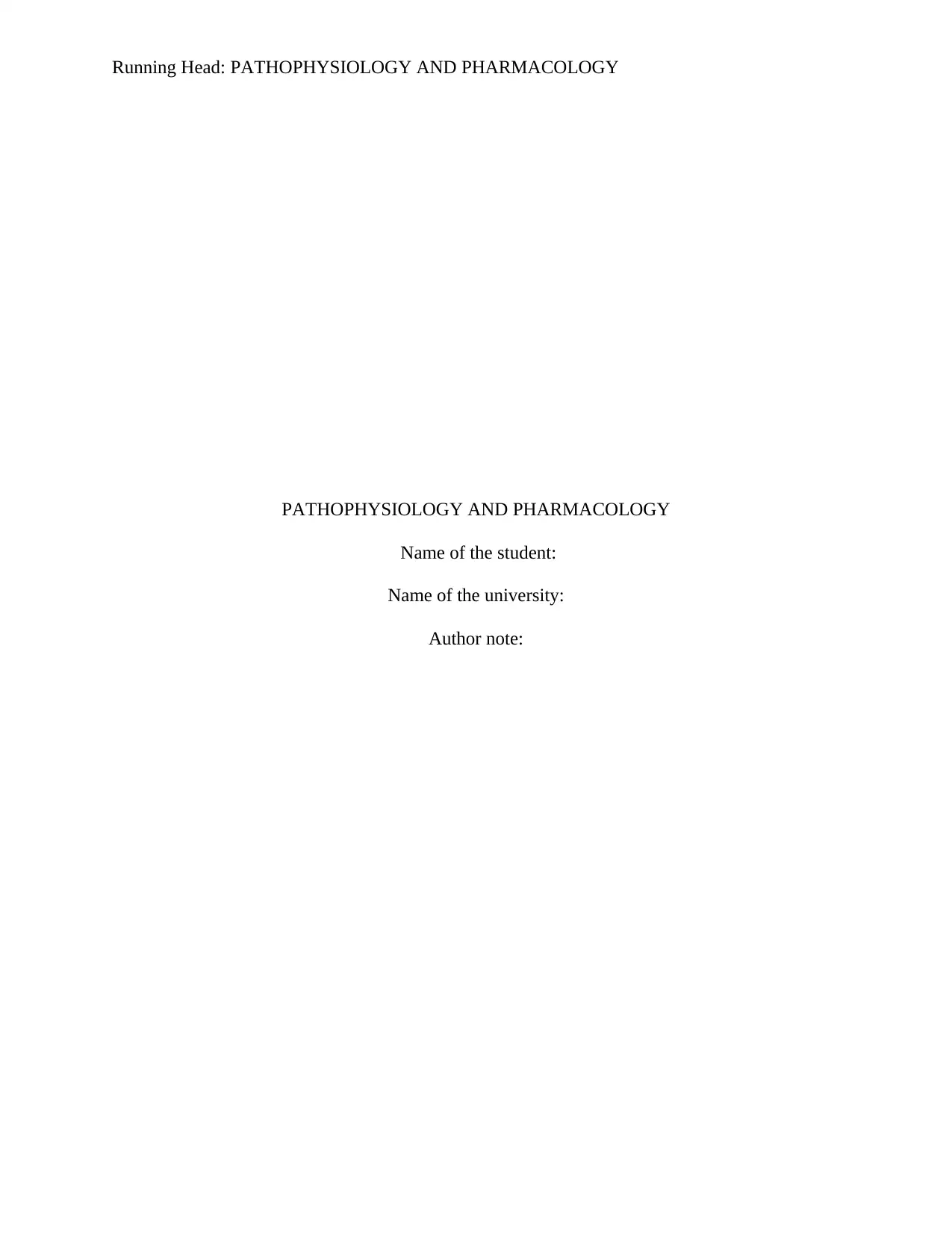
Running Head: PATHOPHYSIOLOGY AND PHARMACOLOGY
PATHOPHYSIOLOGY AND PHARMACOLOGY
Name of the student:
Name of the university:
Author note:
PATHOPHYSIOLOGY AND PHARMACOLOGY
Name of the student:
Name of the university:
Author note:
Paraphrase This Document
Need a fresh take? Get an instant paraphrase of this document with our AI Paraphraser
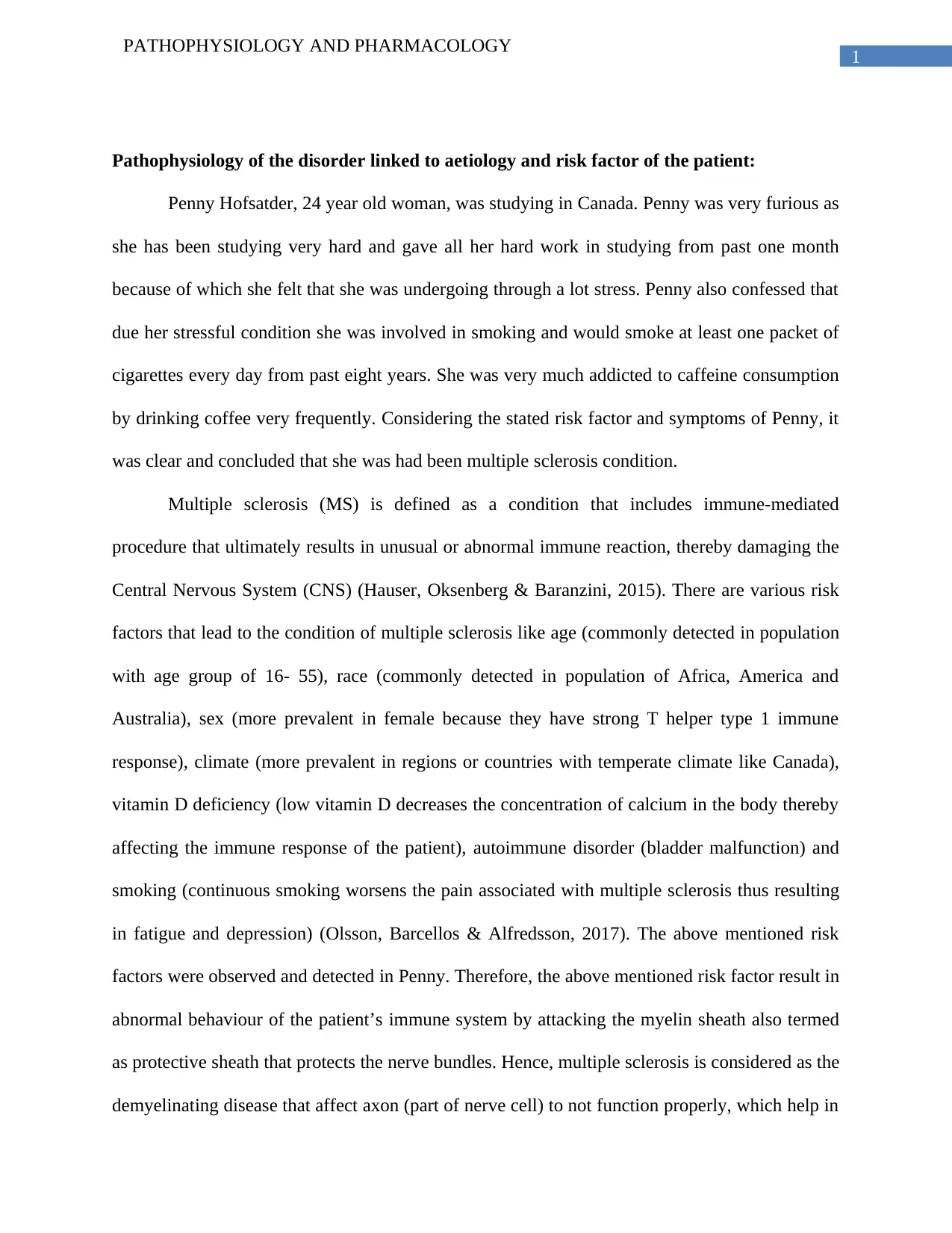
1
PATHOPHYSIOLOGY AND PHARMACOLOGY
Pathophysiology of the disorder linked to aetiology and risk factor of the patient:
Penny Hofsatder, 24 year old woman, was studying in Canada. Penny was very furious as
she has been studying very hard and gave all her hard work in studying from past one month
because of which she felt that she was undergoing through a lot stress. Penny also confessed that
due her stressful condition she was involved in smoking and would smoke at least one packet of
cigarettes every day from past eight years. She was very much addicted to caffeine consumption
by drinking coffee very frequently. Considering the stated risk factor and symptoms of Penny, it
was clear and concluded that she was had been multiple sclerosis condition.
Multiple sclerosis (MS) is defined as a condition that includes immune-mediated
procedure that ultimately results in unusual or abnormal immune reaction, thereby damaging the
Central Nervous System (CNS) (Hauser, Oksenberg & Baranzini, 2015). There are various risk
factors that lead to the condition of multiple sclerosis like age (commonly detected in population
with age group of 16- 55), race (commonly detected in population of Africa, America and
Australia), sex (more prevalent in female because they have strong T helper type 1 immune
response), climate (more prevalent in regions or countries with temperate climate like Canada),
vitamin D deficiency (low vitamin D decreases the concentration of calcium in the body thereby
affecting the immune response of the patient), autoimmune disorder (bladder malfunction) and
smoking (continuous smoking worsens the pain associated with multiple sclerosis thus resulting
in fatigue and depression) (Olsson, Barcellos & Alfredsson, 2017). The above mentioned risk
factors were observed and detected in Penny. Therefore, the above mentioned risk factor result in
abnormal behaviour of the patient’s immune system by attacking the myelin sheath also termed
as protective sheath that protects the nerve bundles. Hence, multiple sclerosis is considered as the
demyelinating disease that affect axon (part of nerve cell) to not function properly, which help in
PATHOPHYSIOLOGY AND PHARMACOLOGY
Pathophysiology of the disorder linked to aetiology and risk factor of the patient:
Penny Hofsatder, 24 year old woman, was studying in Canada. Penny was very furious as
she has been studying very hard and gave all her hard work in studying from past one month
because of which she felt that she was undergoing through a lot stress. Penny also confessed that
due her stressful condition she was involved in smoking and would smoke at least one packet of
cigarettes every day from past eight years. She was very much addicted to caffeine consumption
by drinking coffee very frequently. Considering the stated risk factor and symptoms of Penny, it
was clear and concluded that she was had been multiple sclerosis condition.
Multiple sclerosis (MS) is defined as a condition that includes immune-mediated
procedure that ultimately results in unusual or abnormal immune reaction, thereby damaging the
Central Nervous System (CNS) (Hauser, Oksenberg & Baranzini, 2015). There are various risk
factors that lead to the condition of multiple sclerosis like age (commonly detected in population
with age group of 16- 55), race (commonly detected in population of Africa, America and
Australia), sex (more prevalent in female because they have strong T helper type 1 immune
response), climate (more prevalent in regions or countries with temperate climate like Canada),
vitamin D deficiency (low vitamin D decreases the concentration of calcium in the body thereby
affecting the immune response of the patient), autoimmune disorder (bladder malfunction) and
smoking (continuous smoking worsens the pain associated with multiple sclerosis thus resulting
in fatigue and depression) (Olsson, Barcellos & Alfredsson, 2017). The above mentioned risk
factors were observed and detected in Penny. Therefore, the above mentioned risk factor result in
abnormal behaviour of the patient’s immune system by attacking the myelin sheath also termed
as protective sheath that protects the nerve bundles. Hence, multiple sclerosis is considered as the
demyelinating disease that affect axon (part of nerve cell) to not function properly, which help in
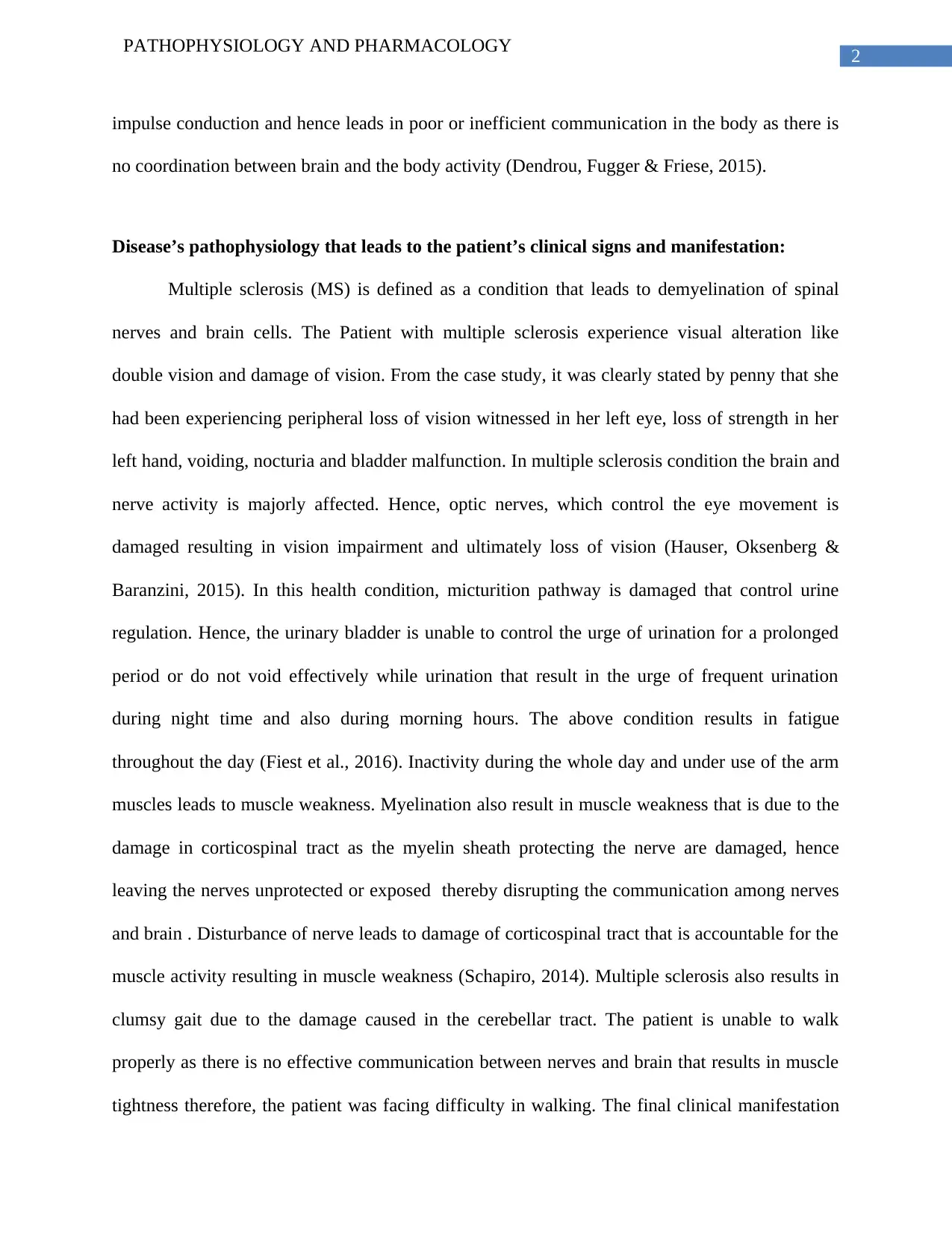
2
PATHOPHYSIOLOGY AND PHARMACOLOGY
impulse conduction and hence leads in poor or inefficient communication in the body as there is
no coordination between brain and the body activity (Dendrou, Fugger & Friese, 2015).
Disease’s pathophysiology that leads to the patient’s clinical signs and manifestation:
Multiple sclerosis (MS) is defined as a condition that leads to demyelination of spinal
nerves and brain cells. The Patient with multiple sclerosis experience visual alteration like
double vision and damage of vision. From the case study, it was clearly stated by penny that she
had been experiencing peripheral loss of vision witnessed in her left eye, loss of strength in her
left hand, voiding, nocturia and bladder malfunction. In multiple sclerosis condition the brain and
nerve activity is majorly affected. Hence, optic nerves, which control the eye movement is
damaged resulting in vision impairment and ultimately loss of vision (Hauser, Oksenberg &
Baranzini, 2015). In this health condition, micturition pathway is damaged that control urine
regulation. Hence, the urinary bladder is unable to control the urge of urination for a prolonged
period or do not void effectively while urination that result in the urge of frequent urination
during night time and also during morning hours. The above condition results in fatigue
throughout the day (Fiest et al., 2016). Inactivity during the whole day and under use of the arm
muscles leads to muscle weakness. Myelination also result in muscle weakness that is due to the
damage in corticospinal tract as the myelin sheath protecting the nerve are damaged, hence
leaving the nerves unprotected or exposed thereby disrupting the communication among nerves
and brain . Disturbance of nerve leads to damage of corticospinal tract that is accountable for the
muscle activity resulting in muscle weakness (Schapiro, 2014). Multiple sclerosis also results in
clumsy gait due to the damage caused in the cerebellar tract. The patient is unable to walk
properly as there is no effective communication between nerves and brain that results in muscle
tightness therefore, the patient was facing difficulty in walking. The final clinical manifestation
PATHOPHYSIOLOGY AND PHARMACOLOGY
impulse conduction and hence leads in poor or inefficient communication in the body as there is
no coordination between brain and the body activity (Dendrou, Fugger & Friese, 2015).
Disease’s pathophysiology that leads to the patient’s clinical signs and manifestation:
Multiple sclerosis (MS) is defined as a condition that leads to demyelination of spinal
nerves and brain cells. The Patient with multiple sclerosis experience visual alteration like
double vision and damage of vision. From the case study, it was clearly stated by penny that she
had been experiencing peripheral loss of vision witnessed in her left eye, loss of strength in her
left hand, voiding, nocturia and bladder malfunction. In multiple sclerosis condition the brain and
nerve activity is majorly affected. Hence, optic nerves, which control the eye movement is
damaged resulting in vision impairment and ultimately loss of vision (Hauser, Oksenberg &
Baranzini, 2015). In this health condition, micturition pathway is damaged that control urine
regulation. Hence, the urinary bladder is unable to control the urge of urination for a prolonged
period or do not void effectively while urination that result in the urge of frequent urination
during night time and also during morning hours. The above condition results in fatigue
throughout the day (Fiest et al., 2016). Inactivity during the whole day and under use of the arm
muscles leads to muscle weakness. Myelination also result in muscle weakness that is due to the
damage in corticospinal tract as the myelin sheath protecting the nerve are damaged, hence
leaving the nerves unprotected or exposed thereby disrupting the communication among nerves
and brain . Disturbance of nerve leads to damage of corticospinal tract that is accountable for the
muscle activity resulting in muscle weakness (Schapiro, 2014). Multiple sclerosis also results in
clumsy gait due to the damage caused in the cerebellar tract. The patient is unable to walk
properly as there is no effective communication between nerves and brain that results in muscle
tightness therefore, the patient was facing difficulty in walking. The final clinical manifestation
⊘ This is a preview!⊘
Do you want full access?
Subscribe today to unlock all pages.

Trusted by 1+ million students worldwide
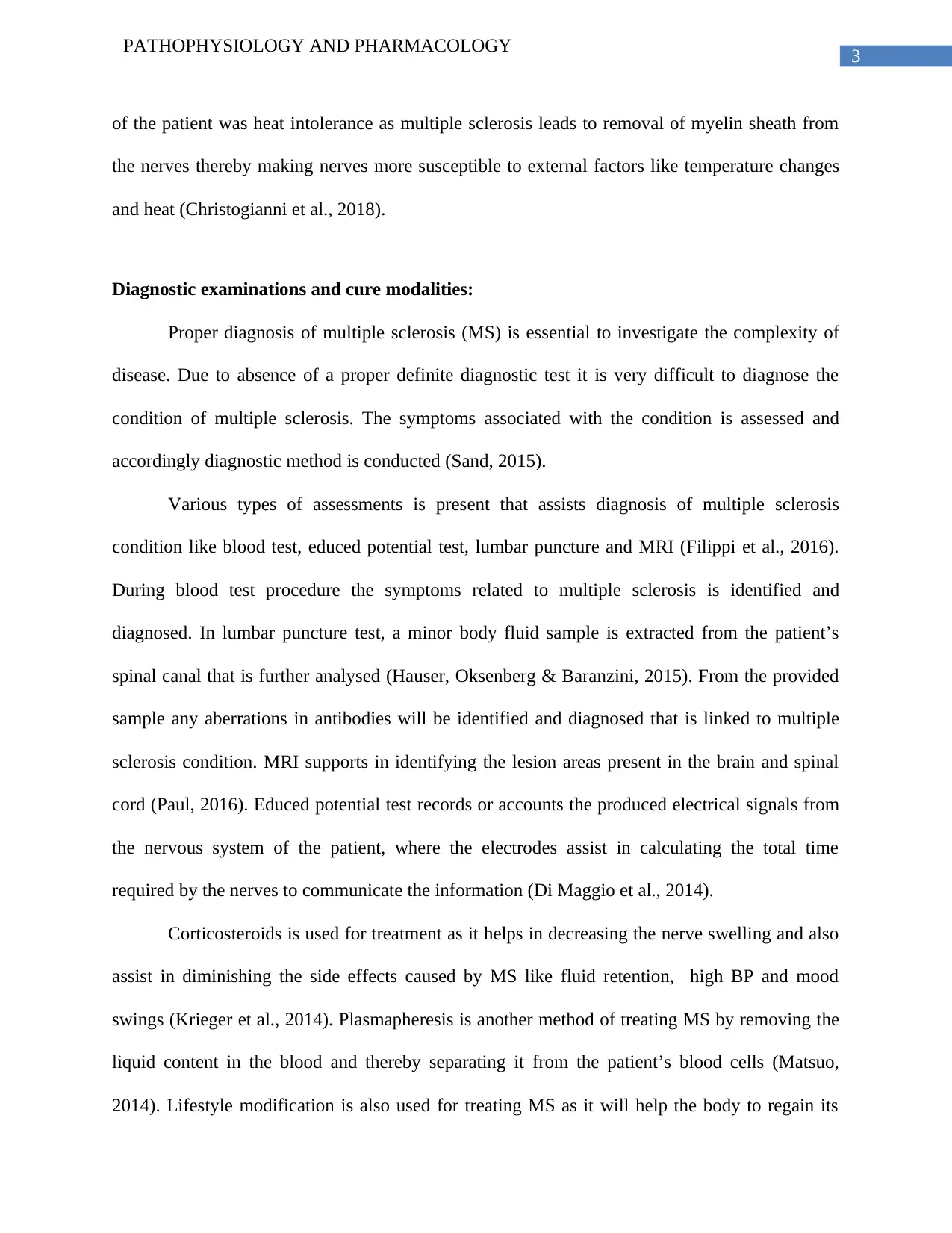
3
PATHOPHYSIOLOGY AND PHARMACOLOGY
of the patient was heat intolerance as multiple sclerosis leads to removal of myelin sheath from
the nerves thereby making nerves more susceptible to external factors like temperature changes
and heat (Christogianni et al., 2018).
Diagnostic examinations and cure modalities:
Proper diagnosis of multiple sclerosis (MS) is essential to investigate the complexity of
disease. Due to absence of a proper definite diagnostic test it is very difficult to diagnose the
condition of multiple sclerosis. The symptoms associated with the condition is assessed and
accordingly diagnostic method is conducted (Sand, 2015).
Various types of assessments is present that assists diagnosis of multiple sclerosis
condition like blood test, educed potential test, lumbar puncture and MRI (Filippi et al., 2016).
During blood test procedure the symptoms related to multiple sclerosis is identified and
diagnosed. In lumbar puncture test, a minor body fluid sample is extracted from the patient’s
spinal canal that is further analysed (Hauser, Oksenberg & Baranzini, 2015). From the provided
sample any aberrations in antibodies will be identified and diagnosed that is linked to multiple
sclerosis condition. MRI supports in identifying the lesion areas present in the brain and spinal
cord (Paul, 2016). Educed potential test records or accounts the produced electrical signals from
the nervous system of the patient, where the electrodes assist in calculating the total time
required by the nerves to communicate the information (Di Maggio et al., 2014).
Corticosteroids is used for treatment as it helps in decreasing the nerve swelling and also
assist in diminishing the side effects caused by MS like fluid retention, high BP and mood
swings (Krieger et al., 2014). Plasmapheresis is another method of treating MS by removing the
liquid content in the blood and thereby separating it from the patient’s blood cells (Matsuo,
2014). Lifestyle modification is also used for treating MS as it will help the body to regain its
PATHOPHYSIOLOGY AND PHARMACOLOGY
of the patient was heat intolerance as multiple sclerosis leads to removal of myelin sheath from
the nerves thereby making nerves more susceptible to external factors like temperature changes
and heat (Christogianni et al., 2018).
Diagnostic examinations and cure modalities:
Proper diagnosis of multiple sclerosis (MS) is essential to investigate the complexity of
disease. Due to absence of a proper definite diagnostic test it is very difficult to diagnose the
condition of multiple sclerosis. The symptoms associated with the condition is assessed and
accordingly diagnostic method is conducted (Sand, 2015).
Various types of assessments is present that assists diagnosis of multiple sclerosis
condition like blood test, educed potential test, lumbar puncture and MRI (Filippi et al., 2016).
During blood test procedure the symptoms related to multiple sclerosis is identified and
diagnosed. In lumbar puncture test, a minor body fluid sample is extracted from the patient’s
spinal canal that is further analysed (Hauser, Oksenberg & Baranzini, 2015). From the provided
sample any aberrations in antibodies will be identified and diagnosed that is linked to multiple
sclerosis condition. MRI supports in identifying the lesion areas present in the brain and spinal
cord (Paul, 2016). Educed potential test records or accounts the produced electrical signals from
the nervous system of the patient, where the electrodes assist in calculating the total time
required by the nerves to communicate the information (Di Maggio et al., 2014).
Corticosteroids is used for treatment as it helps in decreasing the nerve swelling and also
assist in diminishing the side effects caused by MS like fluid retention, high BP and mood
swings (Krieger et al., 2014). Plasmapheresis is another method of treating MS by removing the
liquid content in the blood and thereby separating it from the patient’s blood cells (Matsuo,
2014). Lifestyle modification is also used for treating MS as it will help the body to regain its
Paraphrase This Document
Need a fresh take? Get an instant paraphrase of this document with our AI Paraphraser

4
PATHOPHYSIOLOGY AND PHARMACOLOGY
activity and communicate properly. Adequate exercise, sleep and no consumption of tobacco is
included in this treatment.
PATHOPHYSIOLOGY AND PHARMACOLOGY
activity and communicate properly. Adequate exercise, sleep and no consumption of tobacco is
included in this treatment.
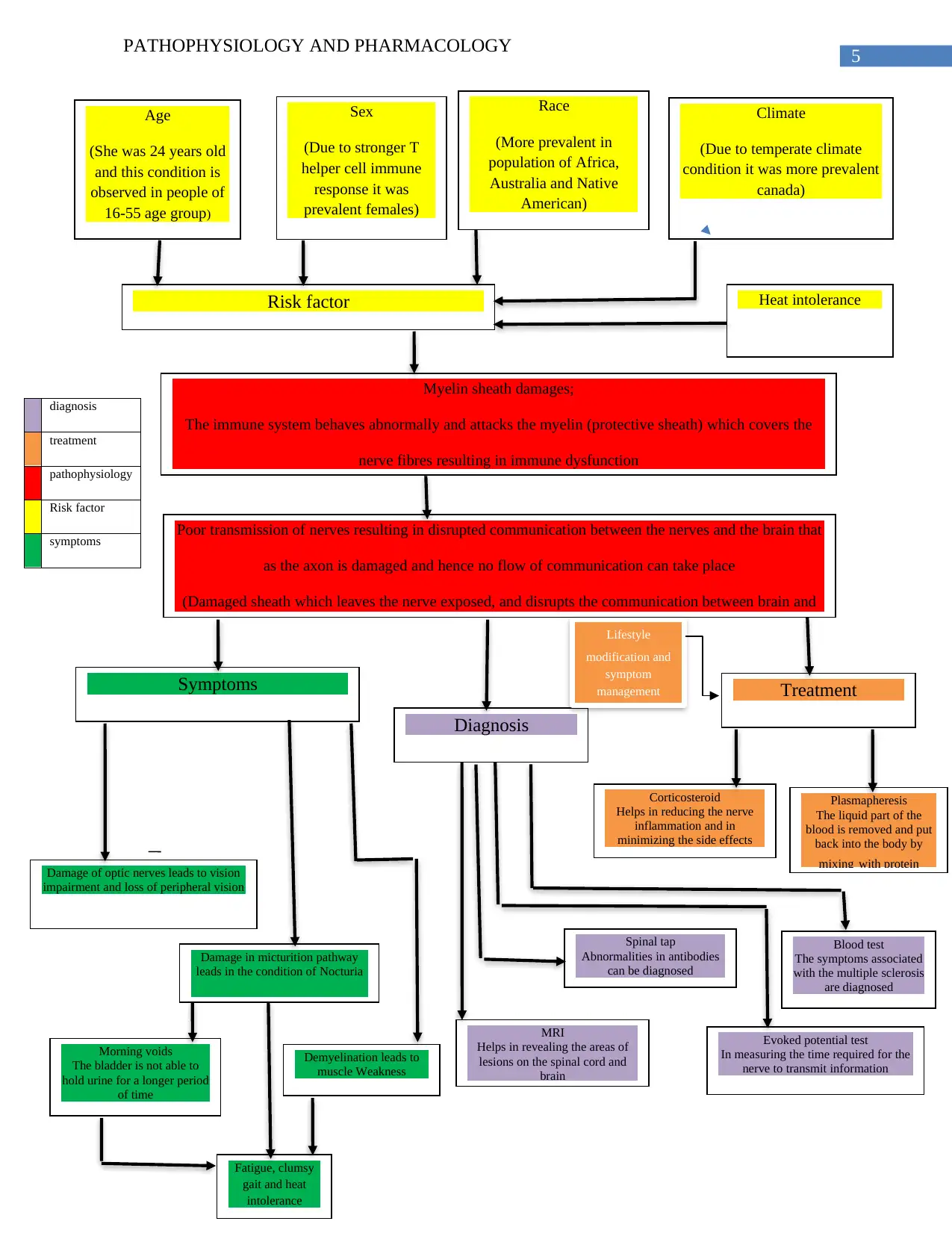
5
PATHOPHYSIOLOGY AND PHARMACOLOGY
Age
(She was 24 years old
and this condition is
observed in people of
16-55 age group)
Race
(More prevalent in
population of Africa,
Australia and Native
American)
Sex
(Due to stronger T
helper cell immune
response it was
prevalent females)
Climate
(Due to temperate climate
condition it was more prevalent
canada)
Risk factor Heat intolerance
Myelin sheath damages;
The immune system behaves abnormally and attacks the myelin (protective sheath) which covers the
nerve fibres resulting in immune dysfunction
Poor transmission of nerves resulting in disrupted communication between the nerves and the brain that
as the axon is damaged and hence no flow of communication can take place
(Damaged sheath which leaves the nerve exposed, and disrupts the communication between brain and
nerves)
Symptoms
Diagnosis
Treatment
MRI
Helps in revealing the areas of
lesions on the spinal cord and
brain
Spinal tap
Abnormalities in antibodies
can be diagnosed
Evoked potential test
In measuring the time required for the
nerve to transmit information
Blood test
The symptoms associated
with the multiple sclerosis
are diagnosed
Corticosteroid
Helps in reducing the nerve
inflammation and in
minimizing the side effects
Plasmapheresis
The liquid part of the
blood is removed and put
back into the body by
mixing with protein
Damage of optic nerves leads to vision
impairment and loss of peripheral vision
Damage in micturition pathway
leads in the condition of Nocturia
Morning voids
The bladder is not able to
hold urine for a longer period
of time
Demyelination leads to
muscle Weakness
Fatigue, clumsy
gait and heat
intolerance
Lifestyle
modification and
symptom
management
diagnosis
treatment
pathophysiology
Risk factor
symptoms
PATHOPHYSIOLOGY AND PHARMACOLOGY
Age
(She was 24 years old
and this condition is
observed in people of
16-55 age group)
Race
(More prevalent in
population of Africa,
Australia and Native
American)
Sex
(Due to stronger T
helper cell immune
response it was
prevalent females)
Climate
(Due to temperate climate
condition it was more prevalent
canada)
Risk factor Heat intolerance
Myelin sheath damages;
The immune system behaves abnormally and attacks the myelin (protective sheath) which covers the
nerve fibres resulting in immune dysfunction
Poor transmission of nerves resulting in disrupted communication between the nerves and the brain that
as the axon is damaged and hence no flow of communication can take place
(Damaged sheath which leaves the nerve exposed, and disrupts the communication between brain and
nerves)
Symptoms
Diagnosis
Treatment
MRI
Helps in revealing the areas of
lesions on the spinal cord and
brain
Spinal tap
Abnormalities in antibodies
can be diagnosed
Evoked potential test
In measuring the time required for the
nerve to transmit information
Blood test
The symptoms associated
with the multiple sclerosis
are diagnosed
Corticosteroid
Helps in reducing the nerve
inflammation and in
minimizing the side effects
Plasmapheresis
The liquid part of the
blood is removed and put
back into the body by
mixing with protein
Damage of optic nerves leads to vision
impairment and loss of peripheral vision
Damage in micturition pathway
leads in the condition of Nocturia
Morning voids
The bladder is not able to
hold urine for a longer period
of time
Demyelination leads to
muscle Weakness
Fatigue, clumsy
gait and heat
intolerance
Lifestyle
modification and
symptom
management
diagnosis
treatment
pathophysiology
Risk factor
symptoms
⊘ This is a preview!⊘
Do you want full access?
Subscribe today to unlock all pages.

Trusted by 1+ million students worldwide
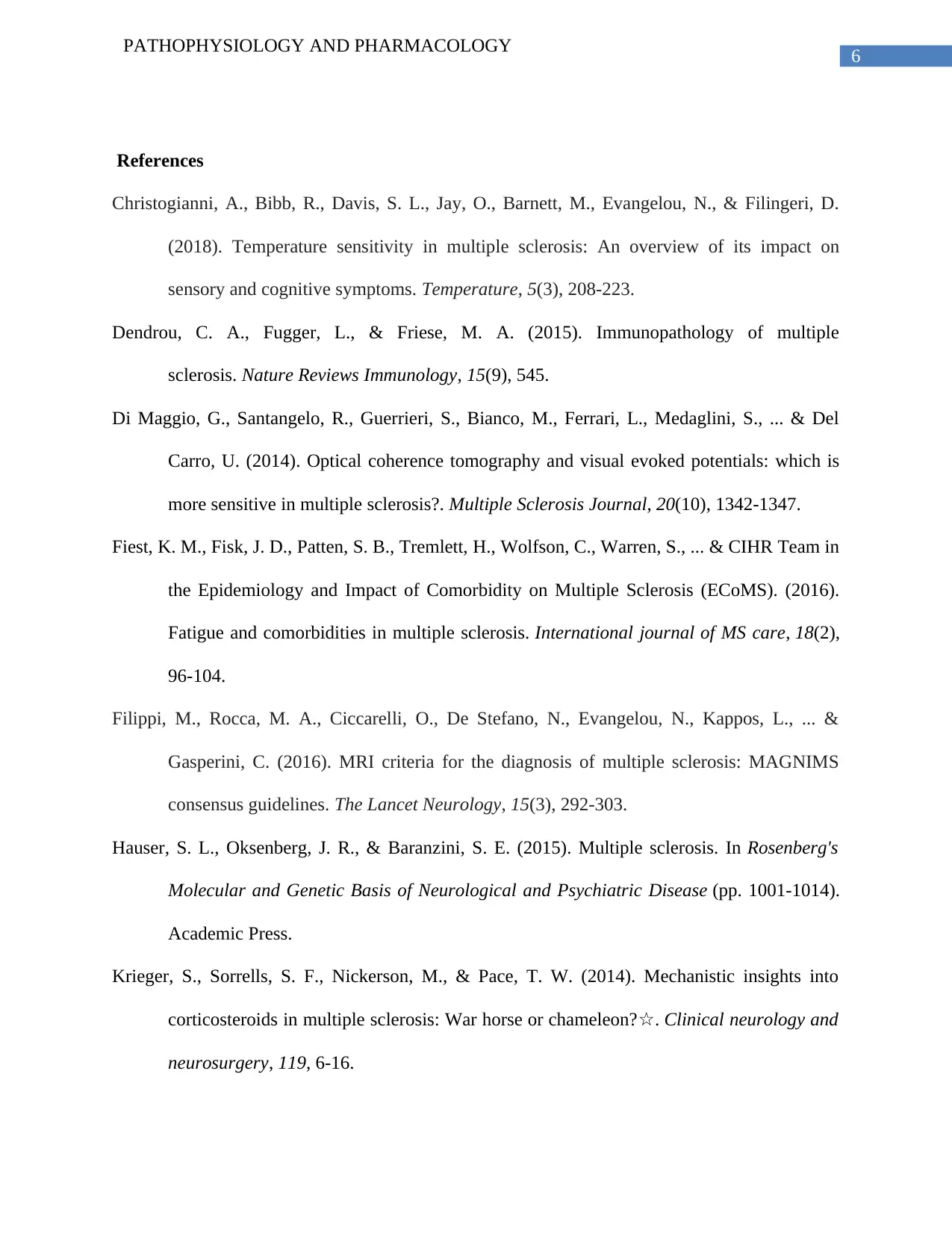
6
PATHOPHYSIOLOGY AND PHARMACOLOGY
References
Christogianni, A., Bibb, R., Davis, S. L., Jay, O., Barnett, M., Evangelou, N., & Filingeri, D.
(2018). Temperature sensitivity in multiple sclerosis: An overview of its impact on
sensory and cognitive symptoms. Temperature, 5(3), 208-223.
Dendrou, C. A., Fugger, L., & Friese, M. A. (2015). Immunopathology of multiple
sclerosis. Nature Reviews Immunology, 15(9), 545.
Di Maggio, G., Santangelo, R., Guerrieri, S., Bianco, M., Ferrari, L., Medaglini, S., ... & Del
Carro, U. (2014). Optical coherence tomography and visual evoked potentials: which is
more sensitive in multiple sclerosis?. Multiple Sclerosis Journal, 20(10), 1342-1347.
Fiest, K. M., Fisk, J. D., Patten, S. B., Tremlett, H., Wolfson, C., Warren, S., ... & CIHR Team in
the Epidemiology and Impact of Comorbidity on Multiple Sclerosis (ECoMS). (2016).
Fatigue and comorbidities in multiple sclerosis. International journal of MS care, 18(2),
96-104.
Filippi, M., Rocca, M. A., Ciccarelli, O., De Stefano, N., Evangelou, N., Kappos, L., ... &
Gasperini, C. (2016). MRI criteria for the diagnosis of multiple sclerosis: MAGNIMS
consensus guidelines. The Lancet Neurology, 15(3), 292-303.
Hauser, S. L., Oksenberg, J. R., & Baranzini, S. E. (2015). Multiple sclerosis. In Rosenberg's
Molecular and Genetic Basis of Neurological and Psychiatric Disease (pp. 1001-1014).
Academic Press.
Krieger, S., Sorrells, S. F., Nickerson, M., & Pace, T. W. (2014). Mechanistic insights into
corticosteroids in multiple sclerosis: War horse or chameleon?☆. Clinical neurology and
neurosurgery, 119, 6-16.
PATHOPHYSIOLOGY AND PHARMACOLOGY
References
Christogianni, A., Bibb, R., Davis, S. L., Jay, O., Barnett, M., Evangelou, N., & Filingeri, D.
(2018). Temperature sensitivity in multiple sclerosis: An overview of its impact on
sensory and cognitive symptoms. Temperature, 5(3), 208-223.
Dendrou, C. A., Fugger, L., & Friese, M. A. (2015). Immunopathology of multiple
sclerosis. Nature Reviews Immunology, 15(9), 545.
Di Maggio, G., Santangelo, R., Guerrieri, S., Bianco, M., Ferrari, L., Medaglini, S., ... & Del
Carro, U. (2014). Optical coherence tomography and visual evoked potentials: which is
more sensitive in multiple sclerosis?. Multiple Sclerosis Journal, 20(10), 1342-1347.
Fiest, K. M., Fisk, J. D., Patten, S. B., Tremlett, H., Wolfson, C., Warren, S., ... & CIHR Team in
the Epidemiology and Impact of Comorbidity on Multiple Sclerosis (ECoMS). (2016).
Fatigue and comorbidities in multiple sclerosis. International journal of MS care, 18(2),
96-104.
Filippi, M., Rocca, M. A., Ciccarelli, O., De Stefano, N., Evangelou, N., Kappos, L., ... &
Gasperini, C. (2016). MRI criteria for the diagnosis of multiple sclerosis: MAGNIMS
consensus guidelines. The Lancet Neurology, 15(3), 292-303.
Hauser, S. L., Oksenberg, J. R., & Baranzini, S. E. (2015). Multiple sclerosis. In Rosenberg's
Molecular and Genetic Basis of Neurological and Psychiatric Disease (pp. 1001-1014).
Academic Press.
Krieger, S., Sorrells, S. F., Nickerson, M., & Pace, T. W. (2014). Mechanistic insights into
corticosteroids in multiple sclerosis: War horse or chameleon?☆. Clinical neurology and
neurosurgery, 119, 6-16.
Paraphrase This Document
Need a fresh take? Get an instant paraphrase of this document with our AI Paraphraser
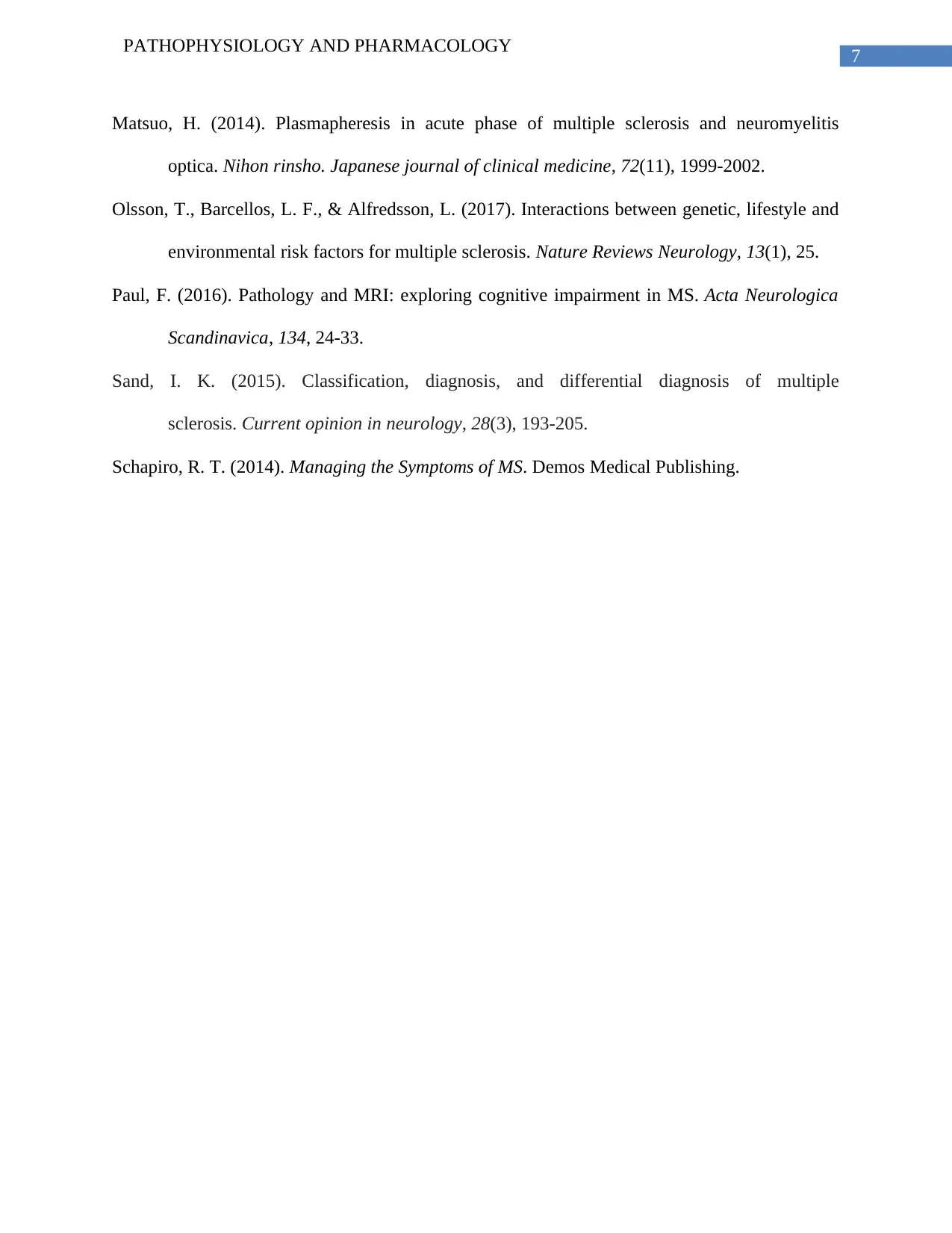
7
PATHOPHYSIOLOGY AND PHARMACOLOGY
Matsuo, H. (2014). Plasmapheresis in acute phase of multiple sclerosis and neuromyelitis
optica. Nihon rinsho. Japanese journal of clinical medicine, 72(11), 1999-2002.
Olsson, T., Barcellos, L. F., & Alfredsson, L. (2017). Interactions between genetic, lifestyle and
environmental risk factors for multiple sclerosis. Nature Reviews Neurology, 13(1), 25.
Paul, F. (2016). Pathology and MRI: exploring cognitive impairment in MS. Acta Neurologica
Scandinavica, 134, 24-33.
Sand, I. K. (2015). Classification, diagnosis, and differential diagnosis of multiple
sclerosis. Current opinion in neurology, 28(3), 193-205.
Schapiro, R. T. (2014). Managing the Symptoms of MS. Demos Medical Publishing.
PATHOPHYSIOLOGY AND PHARMACOLOGY
Matsuo, H. (2014). Plasmapheresis in acute phase of multiple sclerosis and neuromyelitis
optica. Nihon rinsho. Japanese journal of clinical medicine, 72(11), 1999-2002.
Olsson, T., Barcellos, L. F., & Alfredsson, L. (2017). Interactions between genetic, lifestyle and
environmental risk factors for multiple sclerosis. Nature Reviews Neurology, 13(1), 25.
Paul, F. (2016). Pathology and MRI: exploring cognitive impairment in MS. Acta Neurologica
Scandinavica, 134, 24-33.
Sand, I. K. (2015). Classification, diagnosis, and differential diagnosis of multiple
sclerosis. Current opinion in neurology, 28(3), 193-205.
Schapiro, R. T. (2014). Managing the Symptoms of MS. Demos Medical Publishing.
1 out of 8
Related Documents
Your All-in-One AI-Powered Toolkit for Academic Success.
+13062052269
info@desklib.com
Available 24*7 on WhatsApp / Email
![[object Object]](/_next/static/media/star-bottom.7253800d.svg)
Unlock your academic potential
Copyright © 2020–2025 A2Z Services. All Rights Reserved. Developed and managed by ZUCOL.




